Visibility Analysis to Enhance Landscape Protection: A Proposal of Planning Norms and Regulations for Slovakia
Abstract
:1. Introduction
2. Materials and Method
2.1. Landscape Types of Slovak Republic
2.2. Data Availability
2.3. Viewshed Analysis
2.4. GIS Spatial Analysis
2.5. Planning Norms to Safeguard/Protect Hotspots of High Visibility/High Value
3. Results
3.1. Viewshed Analysis
3.2. Spatial Statistics: Most Visible Landscape Types
3.3. Planning Norms
4. Discussion
4.1. Normative Implications for Landscape Protection
4.2. Limitations and Possible Improvements
5. Conclusions
Author Contributions
Funding
Conflicts of Interest
References
- Martín, B.; Ortega, E.; Otero, I.; Arce, R.M. Landscape character assessment with GIS using map-based indicators and photographs in the relationship between landscape and roads. J. Environ. Manag. 2016, 180, 324–334. [Google Scholar] [CrossRef] [PubMed]
- Lim, E.; Honjo, T.; Umeki, K. The validity of VRML images as a stimulus for landscape assess-ment. Landsc. Urban Plan. 2006, 77, 80–93. [Google Scholar] [CrossRef]
- Dramstad, W.; Tveit, M.S.; Fjellstad, W.J.; Fry, G. Relationships between visual landscape preferences and map-based indicators of landscape structure. Landsc. Urban Plan. 2006, 78, 465–474. [Google Scholar] [CrossRef]
- De Groot, M.; Winnubst, M.H.; Van Schie, N.; Van Ast, J.A. Visioning with the Public: Incorporating Public Values in Landscape Planning. Eur. Plan. Stud. 2013, 22, 1165–1181. [Google Scholar] [CrossRef]
- Sahraoui, Y.; Vuidel, G.; Joly, D.; Foltête, J.-C. Integrated GIS software for computing landscape visibility metrics. Trans. GIS 2018, 22, 1310–1323. [Google Scholar] [CrossRef]
- Chamberlain, B.C.; Meitner, M.J. A route-based visibility analysis for landscape management. Landsc. Urban Plan. 2013, 111, 13–24. [Google Scholar] [CrossRef]
- La Rosa, D. The observed landscape: Map of visible landscape values in the province of Enna (Italy). J. Maps 2011, 7, 291–303. [Google Scholar] [CrossRef]
- Wheatley, D. Cumulative viewshed analysis: A GIS-based method for investigating intervisibility, and its archaeological application. In Archaeology and Geographical Information Systems: A European Perspective; Lock, G.R., Stancic, Z., Eds.; Taylor and Francis: London, UK, 1995; pp. 171–185. [Google Scholar]
- Wilson, J.; Lindsey, G.; Liu, G. Viewshed characteristics of urban pedestrian trails, Indianapolis, Indiana, USA. J. Maps 2008, 4, 108–118. [Google Scholar] [CrossRef]
- Domingo-Santos, J.M.; de Villarán, R.F.; Rapp-Arrarás, I.; de Provens, E.C.-P. The visual exposure in forest and rural landscapes: An algorithm and a GIS tool. Landsc. Urban Plan. 2011, 101, 52–58. [Google Scholar] [CrossRef]
- Möller, B. Changing wind-power landscapes: Regional assessment of visual impact on land use and population in Northern Jutland, Denmark. Appl. Energy 2006, 83, 477–494. [Google Scholar] [CrossRef]
- VanHorn, J.E.; Mosurinjohn, N.A. Urban 3D GIS modeling of terrorism sniper hazards. Soc. Sci. Comput. Rev. 2010, 28, 482–496. [Google Scholar] [CrossRef]
- Kalinauskas, M.; Mikša, K.; Inácio, M.; Gomes, E.; Pereira, P. Mapping and assessment of landscape aesthetic quality in Lithuania. J. Environ. Manag. 2021, 286, 112239. [Google Scholar] [CrossRef] [PubMed]
- Wartmann, F.M.; Frick, J.; Kienast, F.; Hunziker, M. Factors influencing visual landscape quality perceived by the public. Results from a national survey. Landsc. Urban Plan. 2021, 208, 104024. [Google Scholar] [CrossRef]
- Ioannidis, R.; Koutsoyiannis, D. A review of land use, visibility and public perception of renewable energy in the context of landscape impact. Appl. Energy 2020, 275, 115367. [Google Scholar] [CrossRef]
- Miklós, L.; Izakovičová, Z.; Boltiziar, M.; Diviaková, A.; Grotkovská, L.; Hrnčiarová, T.; Imrichová, Z.; Kočická, E.; Kočický, D.; Kenderessy, P.; et al. Atlas Reprezentatívnych Geoekosystémov Slovenska; Slovenská Akadémia Vied, Ústav Krajinnej Ekológie, Ministerstvo Školstva SR: Bratislava, Slovakia, 2006; p. 227. [Google Scholar]
- Špulerová, J.; Bezák, P.; Dobrovodská, M.; Lieskovský, J.; Štefunková, D. Traditional agricultural landscapes in Slovakia: Why should we preserve them? Landsc. Res. 2017, 42, 891–903. [Google Scholar] [CrossRef]
- Mazúr, E.; Lukniš, M. Regional geomorphological division of SSR. Geogr. J. 1978, 30, 101. [Google Scholar]
- Tremboš, P.; Minár, J. Morphological-morphometric types of relief in the Slovak Republic. Map 1: 500 000. In Atlas of the Slovak Republic; Ministry of the Environment of the Slovak Republic Bratislava, Slovak Environment Agency Banská Bystrica: Banská Bystrica, Slovakia, 2002; p. 344. ISBN 80-88833-27-2. [Google Scholar]
- Esprit. Digital Terrain Model. Available online: www.esprit-bs.sk (accessed on 15 May 2021).
- Bezák, P.; Izakovičová, Z.; Miklós, L. Representative Landscape Types of Slovakia. (In Slovak: Reprezentatívne Typy Krajiny Slovenska); Institute of Landscape Ecology SAS: Bratislava, Slovakia, 2010; 180p, ISBN 978-80-89325-15-3. [Google Scholar]
- Slovak Road Administration. Available online: www.cdb.sk (accessed on 15 May 2021).
- Tandy, C.R.V. The isovist method of landscape survey. In Methods of Landscape Analysis; Murray, H.C., Ed.; Landscape Research Group: London, UK, 1967; p. 9e10. [Google Scholar]
- Nutsford, D.; Reitsma, F.; Pearson, A.L.; Kingham, S. Personalising the viewshed: Visibility analysis from the human perspective. Appl. Geogr. 2015, 62, 1–7. [Google Scholar] [CrossRef]
- Llobera, M. Extending GIS-based visual analysis: The concept of visualscapes. Int. J. Geogr. Inf. Sci. 2003, 17, 25–48. [Google Scholar] [CrossRef]
- La Rosa, D.; Privitera, R.; Martinico, F.; La Greca, P. Measures of Safeguard and Rehabilitation for landscape protection planning: A qualitative approach based on diversity indicators. J. Environ. Manag. 2013, 127, S73–S83. [Google Scholar] [CrossRef]
- Stephenson, J. The Cultural Values Model: An integrated approach to values in landscapes. Landsc. Urban Plan. 2008, 84, 127–139. [Google Scholar] [CrossRef]
- Pazúr, R.; Bolliger, J. Enhanced land use datasets and future scenarios of land change for Slovakia. Data Brief 2017, 14, 483–488. [Google Scholar] [CrossRef] [PubMed]
- Izakovicova, Z. Implementation of the European Landscape Convention in the Slovak Republic. In Implementation of Landscape Ecological Knowledge in Practice, Proceedings of the 1st IALE-Europe Thematic Symposium; Macias, A., Mizgajski, A., Eds.; Wydawnictwo Naukowe: Poznan, Poland, 2010; pp. 119–125. ISBN 978-83-232-2154-8. [Google Scholar]
- Lieskovský, J.; Bezák, L.; Izakovičová, Z. Protection of representative landscape ecosystem of Slovakia-new landscape ecological approach. In Modern Management of Mine Producing, Geology and Environmental Protection 2: Proceedings of the 10th International Multidisciplinary Scientific Geoconference; SGEM: Albena, Bulgaria, 2010; pp. 717–723. ISBN 978-954-91818-1-4. [Google Scholar]
- Ervin, S.; Steinitz, C. Landscape Visibility Computation: Necessary, but Not Sufficient. Environ. Plan. B Plan. Des. 2003, 30, 757–766. [Google Scholar] [CrossRef]
- Riggs, P.D.; Dean, D.J. An Investigation into the Causes of Errors and Inconsistencies in Predicted Viewsheds. Trans. GIS 2007, 11, 175–196. [Google Scholar] [CrossRef]
- Bishop, I.D.; Miller, D.R. Visual assessment of off-shore wind turbines: The influence of distance, contrast, movement and social variables. Renew. Energy 2007, 32, 814–831. [Google Scholar] [CrossRef]
- Kumsap, C.; Borne, F.; Moss, D. The technique of distance decayed visibility for forest landscape visualization. Int. J. Geogr. Inf. Sci. 2005, 19, 723–744. [Google Scholar] [CrossRef]
- Brehovská, J.; Brunčák, P.; Dedík, L.; Kravjanská, I.; Sučíková, A. Digitization of Cultural Heritage of Slovak Republic. Int. Arch. Photogramm. Remote Sens. Spatial Inf. Sci. 2016, XLI-B5, 421–428. [Google Scholar] [CrossRef] [Green Version]

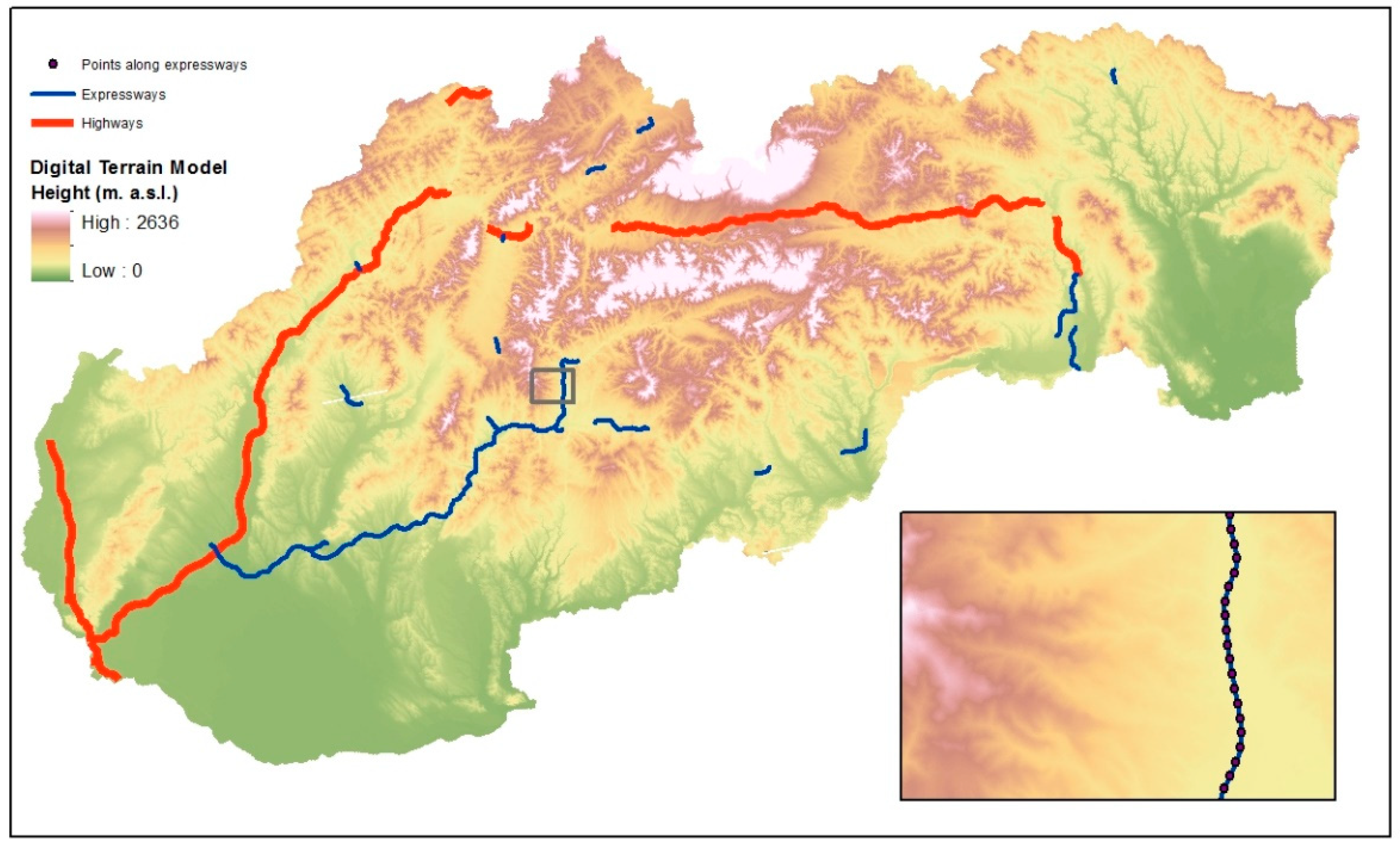

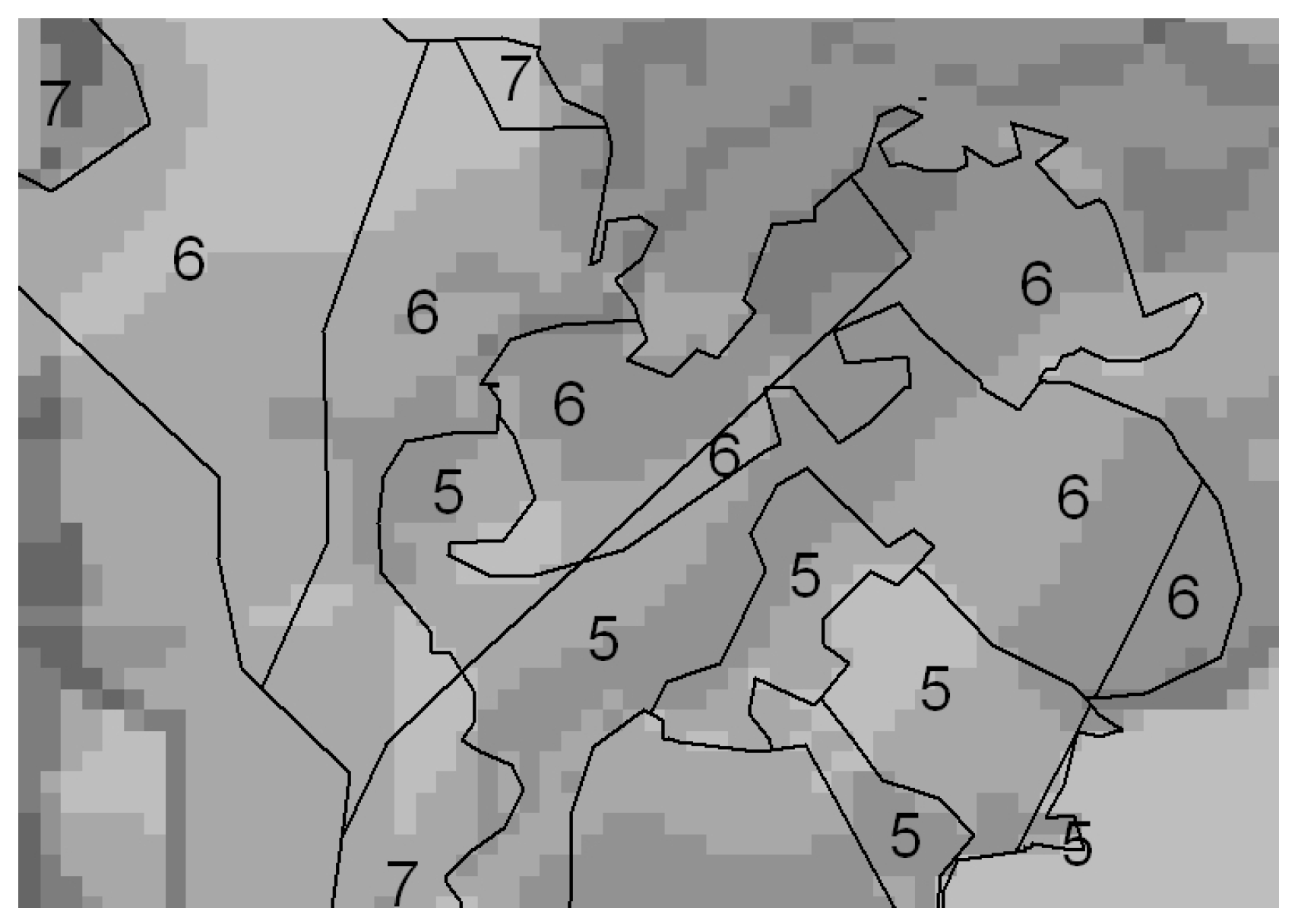
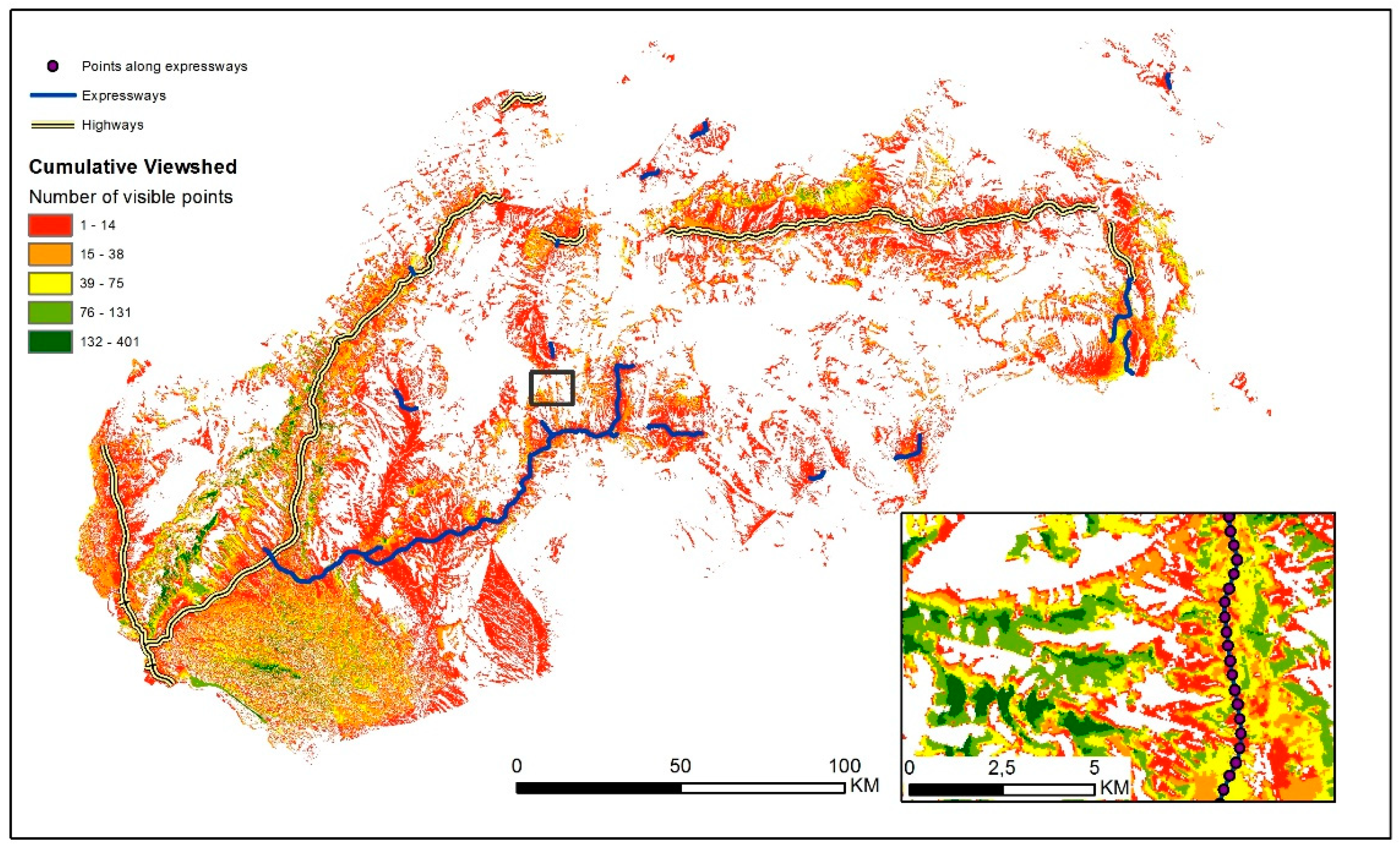

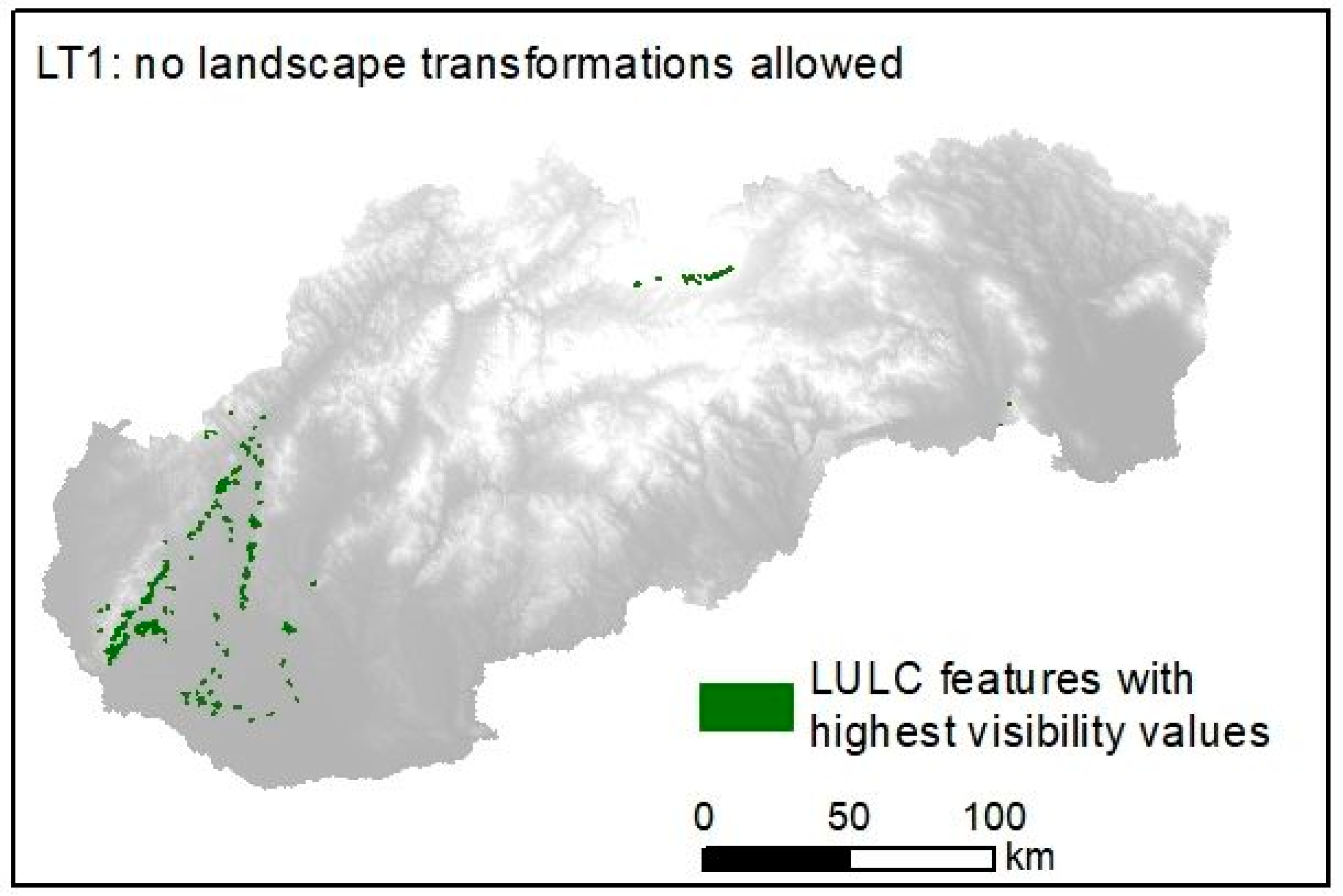

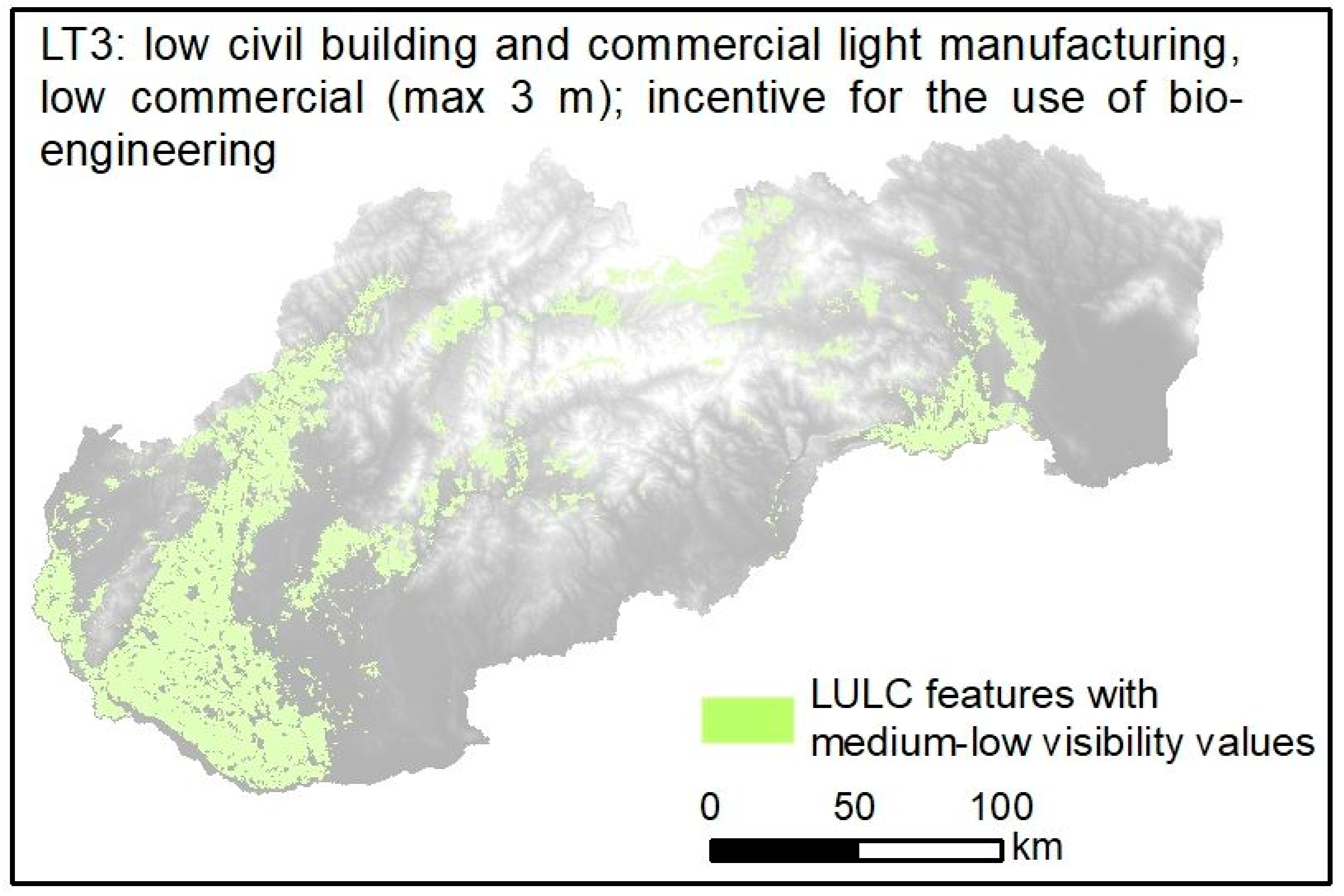
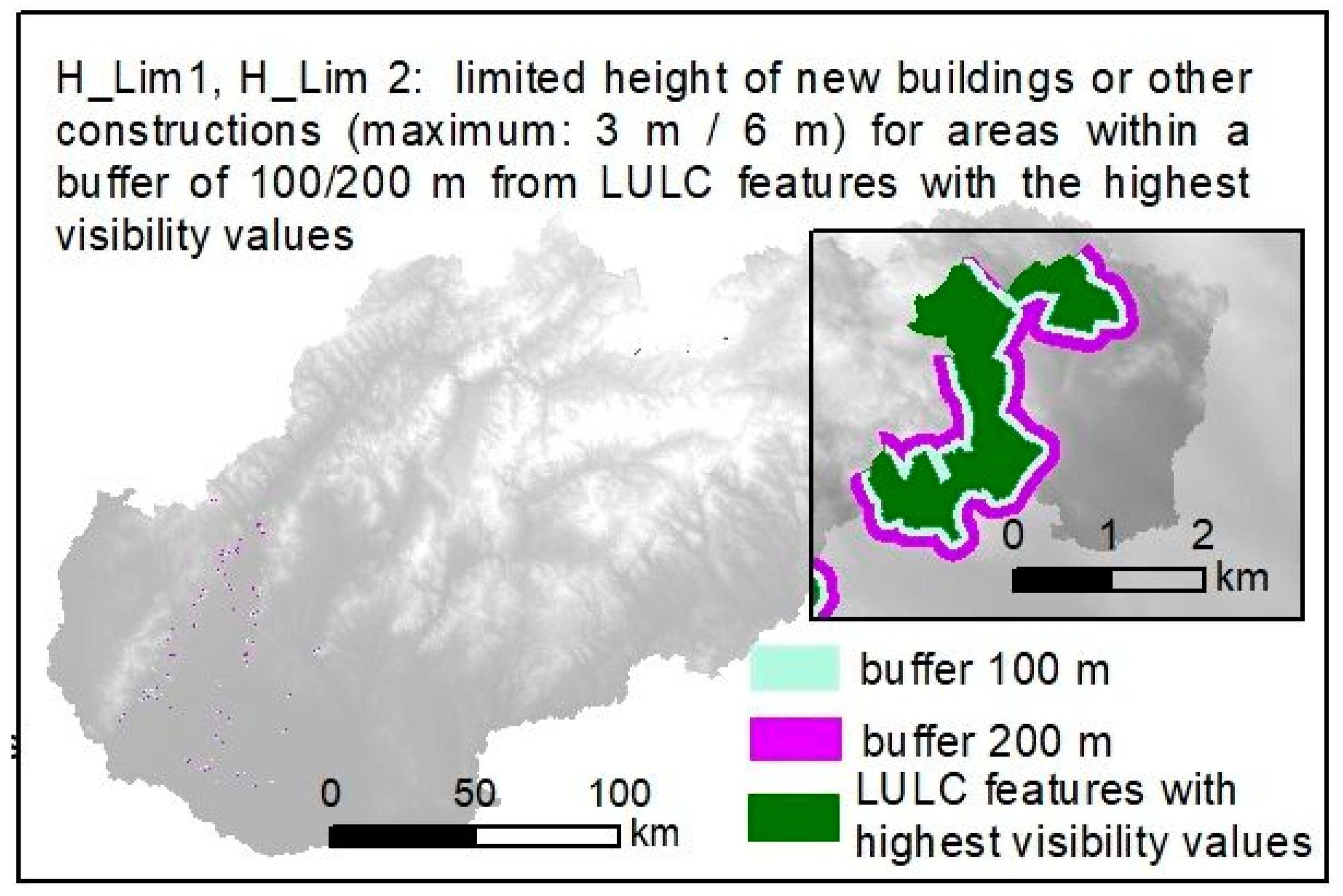
| Height of observer | 1.6 m |
| offset height for observed point | 0 |
| superior vertical angle of observation | 90° |
| inferior vertical angle of observation | −90° |
| left horizontal angle of observation | 0 |
| right horizontal angle of observation | 360 |
| Area (km2) | Max | Average | Std | Sum | Minority | |
|---|---|---|---|---|---|---|
| Landscape Class—Level 1 | ||||||
| lowland landscape | 14,061 | 288 | 9.11 | 21.25 | 51,231,457 | 235 |
| basin landscape | 8940 | 181 | 4.10 | 10.21 | 14,647,664 | 159 |
| mountain landscape | 26,071 | 401 | 3.79 | 15.23 | 39,480,493 | 342 |
| Landscape Class—Level 2 | ||||||
| Wavy plains | 4062 | 233 | 7.27 | 17.83 | 11,819,339 | 203 |
| alluvial plains | 2471 | 157 | 4.89 | 9.68 | 4,835,038 | 131 |
| Hills of basins | 5646 | 181 | 3.59 | 10.10 | 8,101,363 | 159 |
| Uplands | 16,581 | 349 | 3.49 | 15.99 | 23,132,786 | 342 |
| basin uplands | 824 | 151 | 5.19 | 12.14 | 1,711,263 | 103 |
| highlands | 8438 | 401 | 3.48 | 12.10 | 11,743,619 | 277 |
| Plains | 5882 | 234 | 13.25 | 24.97 | 31,171,629 | 222 |
| lowland hills | 4117 | 288 | 5.00 | 17.12 | 8,240,489 | 235 |
| Mountain relief | 1052 | 205 | 10.94 | 22.18 | 4,604,088 | 174 |
| Landscape Class—Level 3 | ||||||
| Wavy plains of river terraces and loess plateaus | 2613 | 228 | 7.21 | 17.63 | 7,539,760 | 194 |
| Core of basins and valleys with alluvial plain | 2471 | 157 | 4.89 | 9.68 | 4,835,038 | 131 |
| Hills of basins and valleys | 5646 | 181 | 3.59 | 10.10 | 8,101,363 | 159 |
| Core of uplands (slopes and ridges) | 13,502 | 349 | 4.09 | 17.44 | 22,093,699 | 342 |
| Uplands of marginal basins and valleys | 824 | 151 | 5.19 | 12.14 | 1,711,263 | 103 |
| Highly broken hills and uplands of intermountain furrows | 2109 | 173 | 0.48 | 3.16 | 405,831 | 77 |
| Less broken uplands with plateaus | 865 | 155 | 0.66 | 3.38 | 227,163 | 56 |
| Less broken highlands with furrows | 352 | 13 | 0.05 | 0.49 | 6562 | 13 |
| Core of highlands (slopes and ridges) | 7587 | 401 | 3.69 | 12.59 | 11,183,393 | 277 |
| Less broken highlands with plateaus | 280 | 93 | 3.44 | 8.72 | 384,672 | 73 |
| Plane depressions | 1225 | 197 | 11.88 | 22.52 | 5,821,463 | 173 |
| Wide alluvial plains | 4657 | 234 | 13.61 | 25.56 | 25,350,166 | 222 |
| Dune planes | 14,492 | 233 | 7.38 | 18.19 | 4,279,579 | 194 |
| Lowland polygenetic hills and flat foothills | 41,171 | 288 | 5.00 | 17.12 | 8,240,489 | 235 |
| Less broken highlands with karst plains | 2200 | 66 | 1.92 | 5.63 | 168,992 | 39 |
| Karst uplands | 1051 | 215 | 9.66 | 25.04 | 406,093 | 76 |
| Mountain relief | 6795 | 141 | 7.12 | 15.18 | 1,935,699 | 126 |
| Glacial mountains relief | 3727 | 205 | 17.90 | 29.89 | 2,668,389 | 174 |
| Corine Land Use Land Cover Class (Level 3) | No Landscape Transformations Allowed LT1 | Limited Landscape Transformations LT2 | Limited Landscape Transformations LT3 | Limited Height of New Buildings | |
|---|---|---|---|---|---|
| Max 3 m, within 100 m H_lim 1 | Max 6 m, within 200 m H_lim 2 | ||||
| Continuous urban fabric | 1560 | 263 | 271 | 0 | 0 |
| Discontinuous urban fabric | 437 | 14,327 | 45,941 | 188 | 192 |
| Industrial or commercial units | 0 | 3474 | 10,086 | 73 | 71 |
| Road and rail networks and associated land | 0 | 319 | 1958 | 0 | 0 |
| Port areas | 0 | 0 | 0 | 0 | 0 |
| Airports | 0 | 388 | 1273 | 0 | 0 |
| Mineral extraction sites | 58 | 493 | 1159 | 0 | 0 |
| Dump sites | 0 | 33 | 540 | 0 | 0 |
| Construction sites | 0 | 235 | 270 | 0 | 0 |
| Green urban areas | 0 | 53 | 646 | 0 | 0 |
| Non-irrigated arable land | 381 | 788 | 1458 | 35 | 33 |
| Permanently irrigated land | 900 | 3575 | 414,789 | 2881 | 2936 |
| Vineyards | 2853 | 3261 | 2677 | 0 | 10 |
| Fruit trees and berry plantations | 350 | 1226 | 1985 | 11 | 9 |
| Pastures | 182 | 2053 | 22,173 | 9 | 9 |
| Complex cultivation patterns | 997 | 7926 | 8508 | 29 | 39 |
| Land principally occupied by agriculture, with significant areas of natural vegetation | 1041 | 6417 | 28,868 | 158 | 155 |
| Broad-leaved forest | 1885 | 65,350 | 201,789 | 571 | 578 |
| Coniferous forest | 307 | 1393 | 71,194 | 306 | 291 |
| Mixed forest | 786 | 6326 | 41,153 | 67 | 59 |
| Natural grasslands | 394 | 296 | 13,611 | 35 | 26 |
| Moors and heathland | 903 | 2192 | 3985 | 54 | 57 |
| Transitional woodland-shrub | 601 | 4416 | 18,422 | 21 | 17 |
| Bare rocks | 0 | 0 | 6142 | 114 | 113 |
| Sparsely vegetated areas | 182 | 0 | 0 | 0 | 0 |
| Inland marshes | 0 | 0 | 476 | 0 | 0 |
| Water courses | 0 | 0 | 1536 | 17 | 16 |
| Water bodies | 58 | 0 | 4690 | 38 | 39 |
Publisher’s Note: MDPI stays neutral with regard to jurisdictional claims in published maps and institutional affiliations. |
© 2022 by the authors. Licensee MDPI, Basel, Switzerland. This article is an open access article distributed under the terms and conditions of the Creative Commons Attribution (CC BY) license (https://creativecommons.org/licenses/by/4.0/).
Share and Cite
La Rosa, D.; Izakovičová, Z. Visibility Analysis to Enhance Landscape Protection: A Proposal of Planning Norms and Regulations for Slovakia. Land 2022, 11, 977. https://doi.org/10.3390/land11070977
La Rosa D, Izakovičová Z. Visibility Analysis to Enhance Landscape Protection: A Proposal of Planning Norms and Regulations for Slovakia. Land. 2022; 11(7):977. https://doi.org/10.3390/land11070977
Chicago/Turabian StyleLa Rosa, Daniele, and Zita Izakovičová. 2022. "Visibility Analysis to Enhance Landscape Protection: A Proposal of Planning Norms and Regulations for Slovakia" Land 11, no. 7: 977. https://doi.org/10.3390/land11070977
APA StyleLa Rosa, D., & Izakovičová, Z. (2022). Visibility Analysis to Enhance Landscape Protection: A Proposal of Planning Norms and Regulations for Slovakia. Land, 11(7), 977. https://doi.org/10.3390/land11070977







